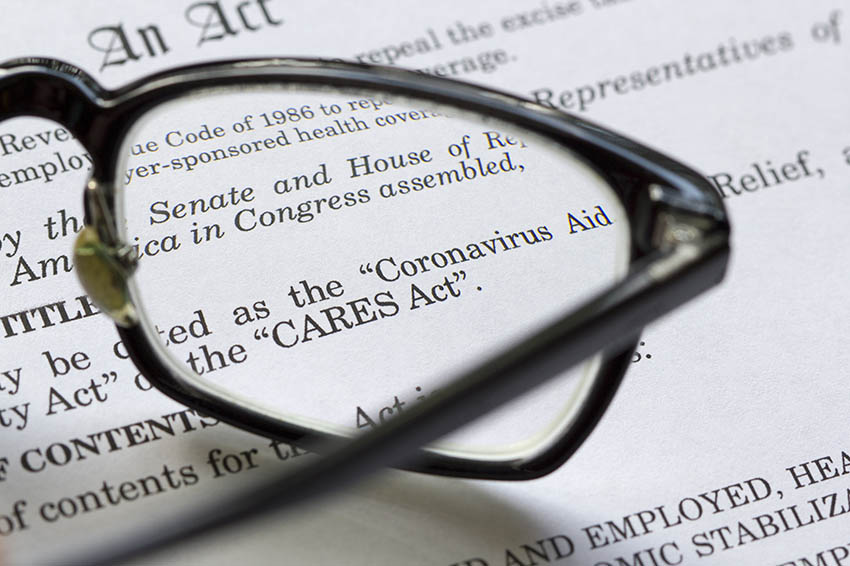How the CARES Act Can Affect Your Retirement Accounts in 2020
Due to market volatility from the COVID-19 pandemic, the balance in your retirement account(s) may be much smaller than even a few short months ago. In response to this economic fallout, Congress passed the Coronavirus Aid, Relief, and Economic Security Act (“CARES”), which was signed into law on March 27, 2020. The CARES Act was primarily aimed at providing quick and substantial relief to individuals and businesses affected by the economic shutdown in response to the spread of COVID-19.
Several of these relief measures can provide significant peace of mind in that they provide you an option to access some of your retirement account funds without the usual penalties, as long as you have been negatively affected by COVID-19. In addition, this new legislation contains other provisions that may lower your tax bill for 2020.
Penalty Tax Waived for 2020 Early Distributions
Under the CARES Act, the 10% early distribution penalty tax that would otherwise apply to the majority of distributions made before a participant turns age 59 ½ is waived for “coronavirus-related distributions” (CRD) made at any time during 2020 from qualified retirement plans (e.g. IRAs, 401(k)s, 403(a) and (b) plans, 457 plans and for distributions of up to $100,000).
A CRD is a distribution from an eligible retirement plan made during 2020 to a qualifying individual who is diagnosed with coronavirus, or whose spouse or dependent has been diagnosed with it, or who has experienced adverse financial consequences from a coronavirus-related quarantine, furlough, layoff, work reduction, business closure or reduction in hours (for business owners) or an inability to work due to lack of childcare related to coronavirus.
These distributions will be subject to income tax, but if you qualify, you may opt to spread the payments evenly over three years rather than having to pay it all in 2020. You may also recontribute the distributed funds to the retirement plan or another retirement plan (with an exception for 457 plan distributions) by a single rollover or multiple rollovers, within three years of the date of the distribution regardless of any contribution limit established by the plan.
COVID-19 Relief for Retirement Account Loans
During the 180-day period from the date of enactment of the CARES Act, plans can increase their loan limits to the lesser of $100,000 or 100% of the participant’s vested account balance for qualified individuals, up from the previous limits of $50,000 or 50% (note that loans are not permitted from IRAs) for participants adversely affected by coronavirus as discussed above.
In addition, qualified individuals with an existing loan from a retirement plan that is due to be repaid by December 31, 2020, can delay repayment by one year. Later repayments will be adjusted to reflect the delayed due date plus interest accruing during the delay. The one-year repayment delay period is disregarded in determining the maximum five-year loan period.
Required Minimum Distributions Waived for 2020
If you are a participant in a 401(k), 403(a) or (b) plan, a 457, or an IRA (not a defined benefit plan), the CARES Act waives required minimum distributions (RMDs) for the 2020 calendar year. So if you do not need the distribution, you can leave the funds in your account and avoid any income tax that would be due if you took a distribution.[1]
The CARES Act waiver also applies to RMDs for retirees who reached age 70 ½ in 2019 but deferred taking an RMD in 2019 until April 1, 2020. Normally, retirees in this category would also have to take a second RMD for 2020 by December 31, 2020, but this RMD is also waived.
Under the previous tax law, an RMD you have taken cannot be rolled back into an IRA unless done within 60 days after the distribution, and a rollover from one IRA to another IRA (or from one Roth IRA to another Roth IRA) can be done only one time per year (365 days).
Under the CARES Act, if you had already taken an RMD prior to the passage of the new law, you are allowed to roll it over into the original account within 60 days, and this time limit was extended by IRS Notice 2020-23 for distributions—including RMDs—taken between February 1st and May 15th if the rollover occurs by July 15th. If you took an RMD in January, it may not be returned unless the IRS provides additional relief.
Although the once-per-year IRA rollover rule is still in effect, if you have already used your IRA rollover, you are permitted to do a rollover to a non-IRA retirement account such as a 401(k). The once-per-year rule does not apply to RMDs taken from a 401(k) or to Roth conversions.
The waiver is also applicable to designated beneficiaries who have inherited retirement accounts. Further, 2020 is not counted for purposes of the post-death payout “five-year rule” applicable to non-designated beneficiaries[2] when the owner died before his or her own required beginning date.
However, the CARES Act has no impact on the new 10-year payout rule required by the SECURE Act, which precludes most non-spousal beneficiaries from stretching their distributions over their lifetime, as 2020 is the first year that non-eligible designated beneficiaries[3] would be subject to that rule when they inherit a retirement account. Because the 10-year payout does not start until the year after the year in which the account owner died, 2021 is deemed “year one” rather than 2020.
Note: If you are 70 ½ years old or older, the CARES Act does not affect your ability to make an annual qualified charitable distribution (QCD) of up to $100,000 from your IRA directly to a qualified charity in 2020 without counting the distribution as taxable income. However, the suspension of RMDs may reduce your incentive for doing so because the distribution will not offset the RMD, thus enabling you to avoid taxable income. However, because a QCD reduces your taxable IRA balance, it will still provide you a tax benefit.
Further, under the CARES Act, individuals who itemize their 2020 deductions can elect to deduct up to 100% (up from 60%) of their adjusted gross income for cash charitable contributions. So if you choose to take a cash distribution from your IRA and contribute that cash to a qualified charity, you can potentially completely offset the tax attributable to the distribution using the charitable deduction.
Review Your Retirement Account Beneficiary Designations in 2020
Now is also a great time to reach out to your financial advisor to review your beneficiary designations. As you know, life circumstances can change very quickly. If a marriage, death, or divorce has occurred since you last reviewed your beneficiary designations, you should give some thought to whether they are still consistent with your estate planning objectives. It would be unfortunate if your retirement funds went to an ex-spouse or someone else you no longer want to benefit. In addition, alternate beneficiaries should be named in case the primary beneficiary passes away before inheriting the account.
If a trust is the beneficiary of your retirement account, it is crucial for us to meet to review your estate plan. Before the SECURE Act was passed, we may have included “conduit” provisions in your trust so that the trust would qualify as a designated beneficiary of a retirement account, allowing the RMDs to pass through to the trust’s primary beneficiary for their individual life expectancy.
Now, conduit trusts are ineffective after ten years, at which point the retirement account balances must be paid directly to the trust’s beneficiaries, which may substantially increase the income taxes they owe and make the entire amount available to claims by their creditors or divorcing spouses. Needless to say, if your estate plan includes this type of trust, it may no longer achieve your goals.
Contact Syntero Group If You Have Been Affected by COVID-19
We have all been affected by COVID-19 in one way or another, but we want to let you know that we are available to help. If you would like to discuss how to best incorporate your retirement account (which may be one of the largest assets you own) into your estate plan or have any other estate planning concerns, please give us a call. Our goal is to make sure that you have the best estate plan in place so you can gain peace of mind from knowing that you and your loved ones are secure, both now and in the future.
Please call or contact us online today to set up a meeting. We are happy to meet with you by telephone or video conference if you prefer.
[1] Under the new SECURE Act, effective January 1, 2020, retirees are typically required to take an RMD from their plan upon reaching age 72.
[2] The plan participant’s estate, a charity, or a trust that does not qualify as a see-through trust.
[3] Beneficiaries who do not fall within one of five categories (surviving spouse, minor child of the participant, disabled beneficiary, chronically ill individuals, beneficiaries less than 10 years younger than the plan participant) of beneficiaries that are still allowed to use the life expectancy payout.


No comments yet. Add the first comment